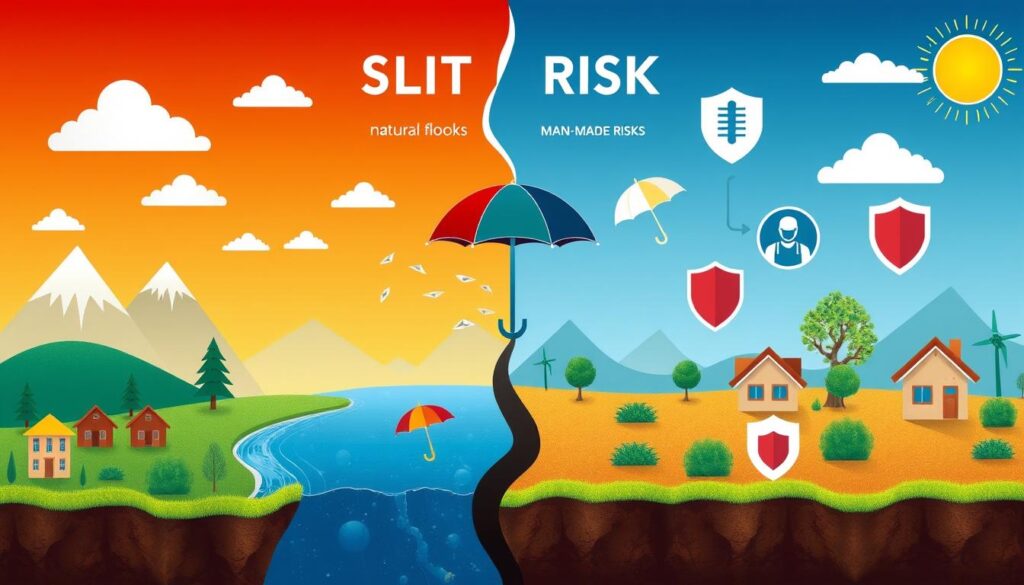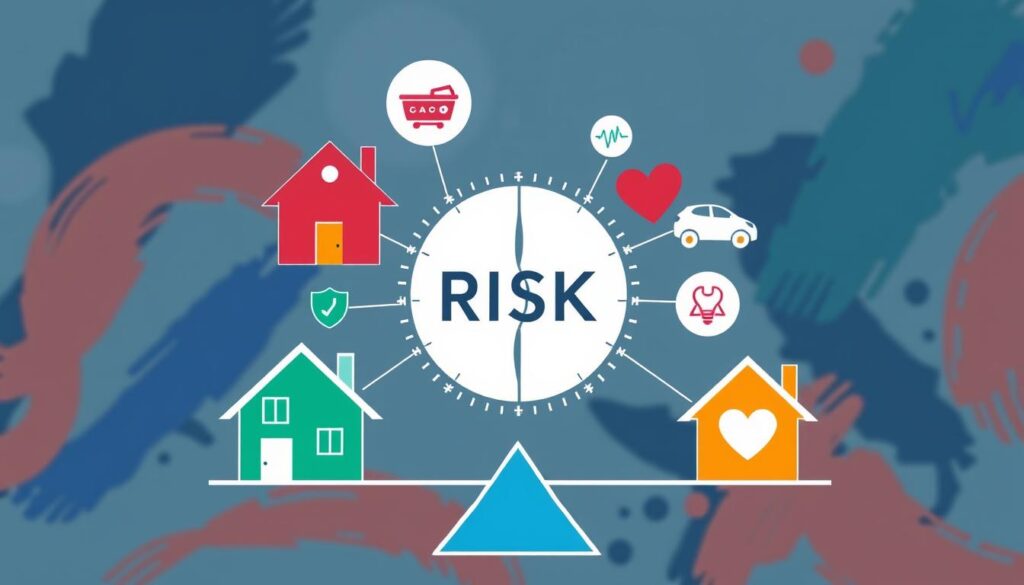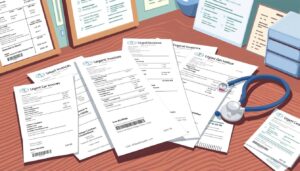Have you ever thought about what split risk in insurance means? It’s a way to share the risk with two or more insurers. This can give you more protection and extra coverage1. For example, a company can get more protection against big disasters, like natural disasters, with a total insurance amount of £500 million1.
Knowing about split risk can help you choose better insurance. It’s about understanding how it works and its benefits. For instance, it can be used in life insurance, where someone earning £1 million might need £4 million in coverage1.
Key Takeaways
- Split risk in insurance refers to the distribution of risk across multiple insurers.
- Split risk definition involves understanding the benefits of spreading risk, including more catastrophe cover and more free cover.
- Insurance split risk explanation is key for making smart insurance choices.
- What is a split risk in insurance applies to various policies, like life and auto insurance.
- Split risk can lower the chance of not having enough insurance in a disaster.
- Grasping split risk is vital for both businesses and individuals to manage risks well.
Understanding Split Risk in Insurance: A Complete Overview
Split risk is a key idea in insurance. It means sharing risk between an insurer and a reinsurer. This helps companies manage risks and offer better coverage to their customers. The2 source says the main job of insurance is to move risk from people or businesses to insurance companies. This protects the assets of those who buy insurance.
In insurance, types of split risk can differ. For example, reinsurance is when an insurer passes some risk to another to avoid big losses. This is called ceding. It lets insurers manage their risks better and give better coverage to their customers. The3 source says the risk charge for reinsurance credit risk in the Life RBC formula is 0.5% of ceded balances.
To grasp how split risk works in insurance, we need to look at its key parts. These include the risk being transferred, how much is being transferred, and the terms of the agreement. The2 source notes that insurance company size is often measured by net premiums written. This is the premium income minus what’s paid for reinsurance. Knowing these parts helps customers choose the right insurance and protect themselves from risks.
In summary, split risk is very important in insurance. Understanding its different parts helps customers make smart choices about their insurance. By looking at the types of split risk in insurance, how split risk works in insurance, and the key parts of split risk coverage, customers can protect themselves well. The3 and2 sources offer great insights into insurance and split risk, showing its big role in the industry.
Common Types of Split Risk Insurance Scenarios
Understanding split risk in insurance is key. There are several types of scenarios, like reinsurance, co-insurance, and layered coverage4. Reinsurance lets an insurer share some risk with another, which can lower its losses5.
Co-insurance means sharing the risk with someone else. It’s good for those who want to pay less for insurance6. Layered coverage, or excess insurance, adds extra protection beyond the main policy. It’s often used in risky fields like construction or manufacturing4.
Some examples of split risk include:
- Reinsurance: transferring risk to another insurer to reduce losses5
- Co-insurance: sharing risk to lower premiums6
- Layered coverage: extra coverage beyond the main policy4
Knowing about split risk in insurance helps make better choices. By looking at different scenarios and examples, people and businesses can handle risks better and cut down on losses5.

| Type of Split Risk | Description | Example |
|---|---|---|
| Reinsurance | Transferring risk to another insurer | Insurer A transfers risk to Insurer B5 |
| Co-insurance | Sharing risk with another party | Individual shares risk with business partner6 |
| Layered Coverage | Providing additional coverage beyond primary policy | Business purchases excess insurance for high-risk activities4 |
How Split Risk Affects Your Insurance Coverage and Premiums
Knowing what a split risk in insurance means is key to handling it well. It can make policies more complex but offers benefits like more protection against disasters and more free coverage7. It’s important to see how it changes your coverage and what you pay for it. Split risk can make policies more complicated8.
Split risk can also mean higher costs because of the policy’s complexity9. But, understanding split risk can help you make smart choices. This might include talking clearly with your insurers and checking your coverage often to avoid any issues7. By doing this, you can handle split risk better and get the most from your insurance.

- Ensure clear communication with your insurers
- Regularly review your coverage to prevent overlap or gaps
- Understand the split risk definition and how it applies to your insurance coverage
By following these tips, you can manage split risk better and make informed choices about your insurance8.
Conclusion: Making Informed Decisions About Split Risk Insurance
Understanding split risk insurance is key when managing your insurance10. It usually covers up to $100,000 for each person hurt, $300,000 for all hurt in an accident, and $50,000 for property damage10. You can also get a combined single limit (CSL) policy. This offers up to $500,000 for all claims from one accident10.
Think about when damages might be more than what split-limit policies cover10. A CSL policy might offer more protection and avoid extra costs10. But, it often costs more10. Companies with valuable cargo or in busy areas might find CSL policies worth it10.
To make a smart choice about split risk insurance, look at your risks, needs, and budget10. Knowing about split risk and the options can help protect your assets and finances10. Talking to an insurance expert can help you understand split risk better and find what’s best for you.
FAQ
What is a split risk in insurance?
In insurance, a split risk means an insurer shares the risk with others. This can be with other insurers or reinsurers. It helps the insurer manage big claims and avoid being overwhelmed.
What are the key components of split risk coverage?
Key parts of split risk coverage are reinsurance, co-insurance, and layered coverage. Reinsurance is when an insurer passes some risk to another. Co-insurance means sharing the risk with others. Layered coverage has multiple policies, like primary and excess.
Why is split risk important in insurance?
Split risk is key because it lets insurers handle big risks better. It helps them offer more coverage without taking too much risk. This way, they can protect more people without getting overwhelmed.
What are the common types of split risk insurance scenarios?
Common scenarios include reinsurance, co-insurance, and layered coverage. For instance, a business might use reinsurance to share some risk. An individual might use co-insurance to split the risk with someone else.
How does split risk affect insurance coverage and premiums?
Split risk can change how much coverage you get and how much you pay. It can affect policy terms and costs. It’s important to make sure all insurers know what each other covers. Working with an experienced insurance pro can help you understand your options.
Source Links
- What is Split Insurance? | MetLife Academy – https://www.metlife.co.uk/intermediary/training/metlife-academy/risk/split-insurance/
- PDF – https://www.iii.org/sites/default/files/docs/pdf/Insurance_Handbook_20103.pdf
- Comparison of the NAIC Life, P&C and Health RBC Formulas – https://www.actuary.org/sites/default/files/pdf/finreport/RBC_0801.pdf
- What Are Split Limits in Auto Insurance? – Policygenius – https://www.policygenius.com/auto-insurance/what-are-split-limits-in-insurance/
- Split-Dollar Life Insurance: Risks, Benefits and Key Considerations – SullivanCotter – https://sullivancotter.com/split-dollar-life-insurance-risks-benefits-and-key-considerations/
- What is split limit insurance? (2025) – https://insurify.com/car-insurance/coverage/split-limit-insurance/
- Risk Pooling: How Health Insurance in the Individual Market Works – https://www.actuary.org/content/risk-pooling-how-health-insurance-individual-market-works-0
- Split-Dollar Life Insurance – https://www.newyorklife.com/articles/split-dollar-life-insurance
- Splitting the Difference: Why Careful Structuring and Regular Monitoring of a Split-Dollar Life Insurance Plan Might Benefit Employers and Employees | Faegre Drinker Biddle & Reath LLP – https://www.faegredrinker.com/en/insights/publications/2023/8/careful-structuring-regular-monitoring-split-dollar-life-ins-plan-might-benefit-employers-employees
- Deciphering the Divide: A Deep Dive into Combined Single Limit vs. Split Limits in Commercial Auto Coverage – https://www.nycbusinessgroup.com/insurance/blog-post/deciphering-the-divide-a-deep-dive-into-combined-single-limit-vs-split-limits-in-commercial-auto-coverage/








